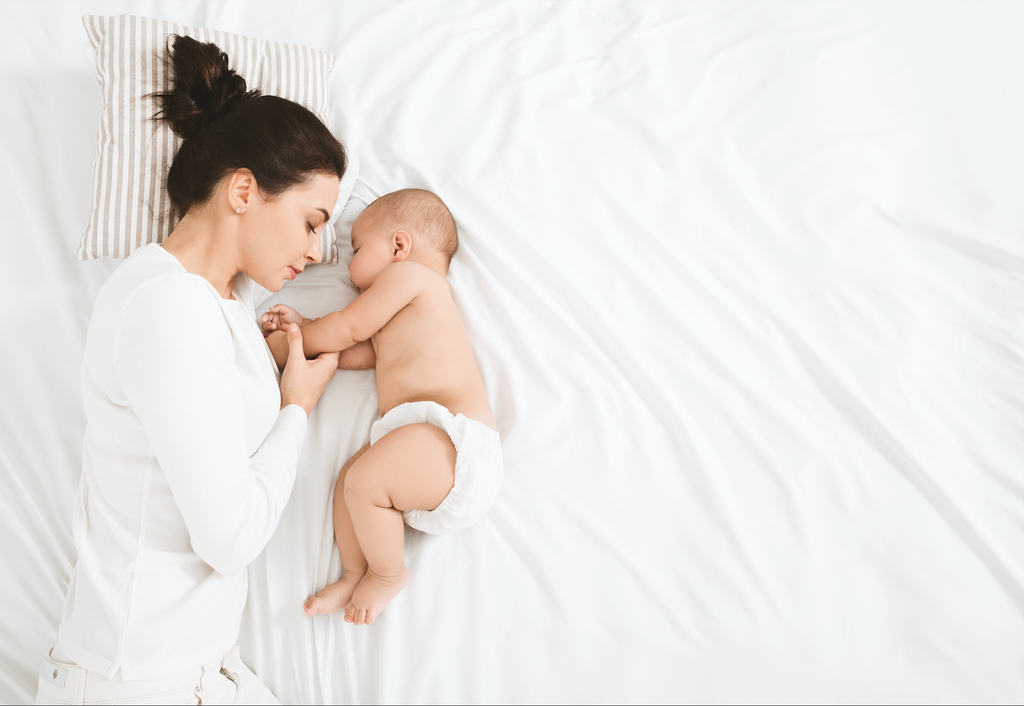
Sleep is important for your new baby. You know this because that’s probably how they’re spending most of their time — sleeping. But you want to make sure that not only are they getting sleep, but that they’re getting good quality sleep, especially at night.
As your baby gets bigger, those bedtime routines actually have an impact on their wellbeing because it can mean that they’re getting good quality sleep.
When Should You Start a Bedtime Routine for Your Baby?
A newborn baby isn’t going to follow a set routine or a sleep schedule. They sleep when they sleep. Make sure that they’re getting enough sleep.
As you help them fall asleep, try to observe and notice cues of things that you do that help your baby relax and fall asleep. Is it music? Do you have a rocking motion? Or are they bundled up nice a warm? These are things that you can incorporate in a bedtime routine that are familiar to your baby and can help them fall asleep faster.
When your baby is about 6-8 weeks old, you can start to put together a bedtime routine.
What is a Good Bedtime Routine for My Baby?
Every baby is different. There isn’t one right bedtime routine for your baby. It’s going to take some experimenting to find the right elements for a good bedtime routine for your baby.
As I talked about before, you want to incorporate habits that you formed with helping your baby sleep during their first few weeks of life. You don’t need to incorporate everything. Good habits are ones that are easy to repeat and shouldn’t be demanding for you or anyone else to do. Especially as your baby gets older, the repetitive nature is what actually matters. Those repeated steps help cue your baby’s brain and body that it’s time to go to sleep.
Remember, your bedtime routine can start 1 hour before your baby needs to go to sleep or 15 minutes. Consider some of these ideas to incorporate into your baby’s bedtime routine:
- Give baby a bath
- Put on a clean diaper and apply lotion
- Dress in clean pajamas or a knotted gown
- Swaddle baby in a blanket
- Dim or darken the room
- Nurse or feed your baby
- Turn on ambient noise
- Burp baby
- Gently rock or snuggle
Before you put your baby in their crib, he or she should be very drowsy. Once you’ve put your baby in your crib, you can try and leave the room.
How Do You Get a Baby Into a Sleep Routine?
This is the hardest part of the bedtime routine — knowing when to start implementing the sleep routine. Should you start doing everything at once? How do you know what time to start the routine? Here are a few ideas.
Notice Your Baby’s Sleep Tendencies.
As you start to fall into a pattern for night time, start taking note of when your baby goes to sleep for the longest stretch of the night. Jot a note on your phone or maintain a sleep log as your baby starts to develop patterns. Once you notice the pattern, plan on starting the bedtime routine 30 to 45 minutes before that time. Maybe your baby starts to go to sleep around 8:30 p.m. and will be asleep for a long stretch in the night. You’ll want to start the bedtime routine around 7:45 or 8 p.m.
Adopt Rituals Slowly.
Start with some rituals that you’ve already done for your baby when you’ve put them down. A bath. A favorite blanket. Try to be consistent so that these are always associated with going to bed. If you want to introduce a new ritual, only incorporate one new bedtime ritual at a time. Make sure that your baby is still going to sleep and waking up at about the same time before introducing another ritual. Changes can disrupt the routine so be conscious of that.
Incorporate Routine During the Day.
If there’s a naptime during the day, trying to modify it to fit for naptime. Incorporate those sleep associations to help your baby fall asleep during the day. This will also help reinforce this routine for better periods of sleep at night.
Put Your Baby to Sleep in the Same Place.
Speaking of having consistency, try to put your baby down for naps and bedtime in the same place every time. While it might be tempting to put your baby in the car seat and drive around to run errands while he or she is asleep, you’re also training your baby to sleep in his or her car seat while the car is moving. You don’t want to have to manage that at night or for every nap. We know that it’s inevitable that your baby will fall asleep on a car ride or in their stroller, but try an 90/10 approach – 90% of the time baby should be sleeping in their bed.
There Will be a Learning Curve.
Setting a bedtime routine requires a bit of trial and error. Sometimes it will work. Other times it won’t. As your baby gets bigger, you may have to remove some of the rituals because they no longer provide the same cue of bedtime. A bath that was once relaxing can turn into rowdy playtime as baby gets older. This is a process so don’t stress when you need to change things.
Master the Baby Drop-Off.
You will be so grateful that you did. What this means is to try to make sure your baby isn’t completely asleep when you lay her or him down in their bed. Try to get them to a calm, relaxed state that some call “drowsy by awake.” Your baby is probably starting to nod off a little but hasn’t gotten completely to the sleep stage. By putting your baby down at this point, you actually help train your baby to fall asleep without someone holding them.
A bedtime routine isn’t just for your baby. It’s also something that you will be grateful for. Following a routine can help you prepare for your own bedtime but also give you the peace of mind that your baby is ready to go to sleep too.

Leave a Reply